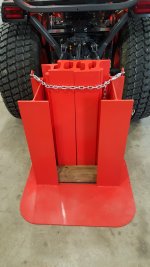CincyFlyer
Veteran Member
One thing to consider: with the increased density (over concrete) of steel, iron, or lead, you can put the weight low (better!) and even as wide (either up to, or behind, the back tires) to make the tractor more stable. I used a Titan ballast box, filled the bottom with chunks of iron, and the remainder with sand and concrete. Likely weighs ~800 lbs, which is plenty for most uses.


